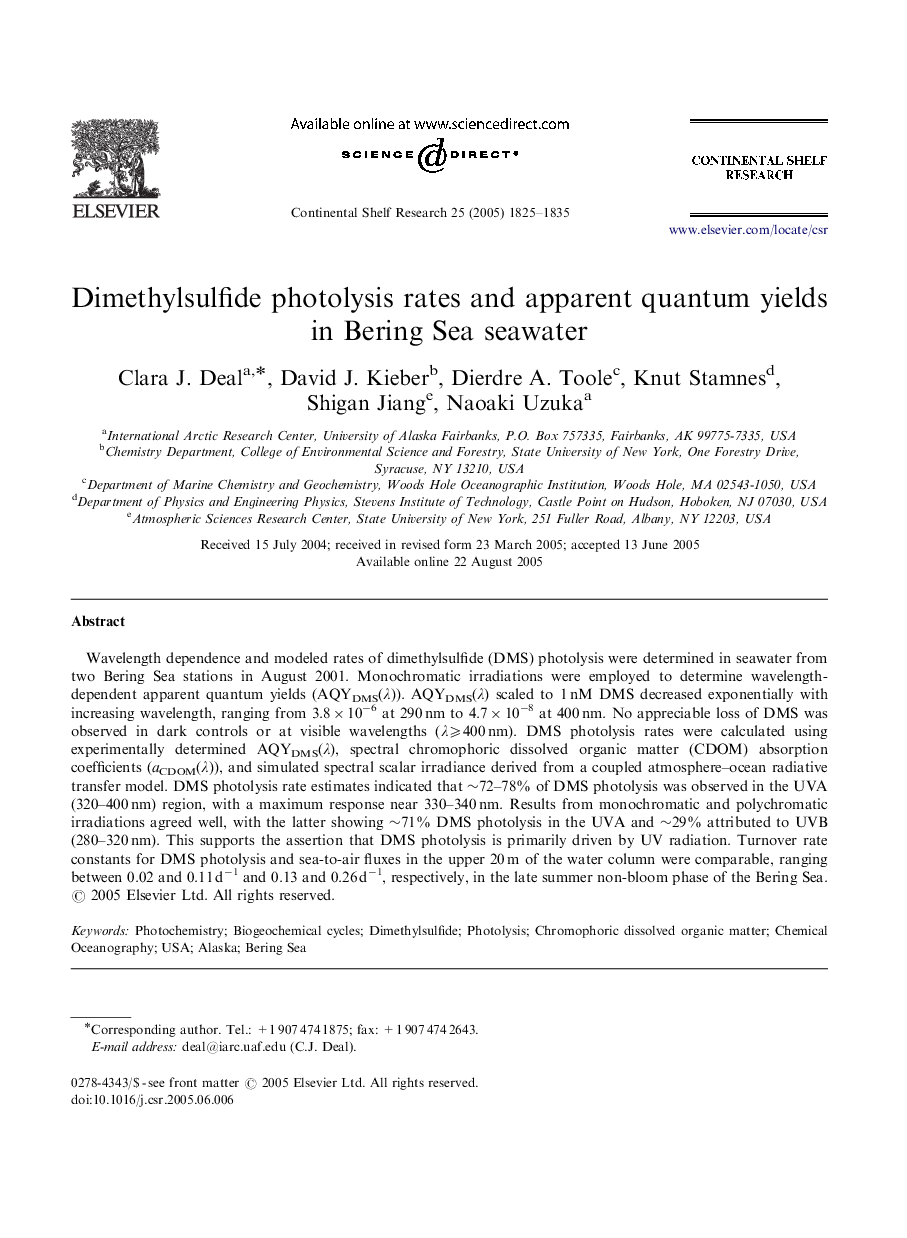| کد مقاله | کد نشریه | سال انتشار | مقاله انگلیسی | نسخه تمام متن |
|---|---|---|---|---|
| 9479189 | 1325272 | 2005 | 11 صفحه PDF | دانلود رایگان |
عنوان انگلیسی مقاله ISI
Dimethylsulfide photolysis rates and apparent quantum yields in Bering Sea seawater
دانلود مقاله + سفارش ترجمه
دانلود مقاله ISI انگلیسی
رایگان برای ایرانیان
کلمات کلیدی
Alaska - آلاسکاchemical oceanography - اقیانوس شناسی شیمیاییUSA - ایالات متّحدهٔ آمریکاBering Sea - دریای برینگDimethylsulfide - دی متیل سولفیدPhotolysis - عکسبرداریPhotochemistry - فتوشیمی یا نورشیمی chromophoric dissolved organic matter - ماده آلی محلول کروموفوریک استbiogeochemical cycles - چرخه بیوگرافی شیمیایی
موضوعات مرتبط
مهندسی و علوم پایه
علوم زمین و سیارات
زمین شناسی
پیش نمایش صفحه اول مقاله

چکیده انگلیسی
Wavelength dependence and modeled rates of dimethylsulfide (DMS) photolysis were determined in seawater from two Bering Sea stations in August 2001. Monochromatic irradiations were employed to determine wavelength-dependent apparent quantum yields (AQYDMS(λ)). AQYDMS(λ) scaled to 1 nM DMS decreased exponentially with increasing wavelength, ranging from 3.8Ã10â6 at 290 nm to 4.7Ã10â8 at 400 nm. No appreciable loss of DMS was observed in dark controls or at visible wavelengths (λ⩾400 nm). DMS photolysis rates were calculated using experimentally determined AQYDMS(λ), spectral chromophoric dissolved organic matter (CDOM) absorption coefficients (aCDOM(λ)), and simulated spectral scalar irradiance derived from a coupled atmosphere-ocean radiative transfer model. DMS photolysis rate estimates indicated that â¼72-78% of DMS photolysis was observed in the UVA (320-400 nm) region, with a maximum response near 330-340 nm. Results from monochromatic and polychromatic irradiations agreed well, with the latter showing â¼71% DMS photolysis in the UVA and â¼29% attributed to UVB (280-320 nm). This supports the assertion that DMS photolysis is primarily driven by UV radiation. Turnover rate constants for DMS photolysis and sea-to-air fluxes in the upper 20 m of the water column were comparable, ranging between 0.02 and 0.11 dâ1 and 0.13 and 0.26 dâ1, respectively, in the late summer non-bloom phase of the Bering Sea.
ناشر
Database: Elsevier - ScienceDirect (ساینس دایرکت)
Journal: Continental Shelf Research - Volume 25, Issue 15, September 2005, Pages 1825-1835
Journal: Continental Shelf Research - Volume 25, Issue 15, September 2005, Pages 1825-1835
نویسندگان
Clara J. Deal, David J. Kieber, Dierdre A. Toole, Knut Stamnes, Shigan Jiang, Naoaki Uzuka,